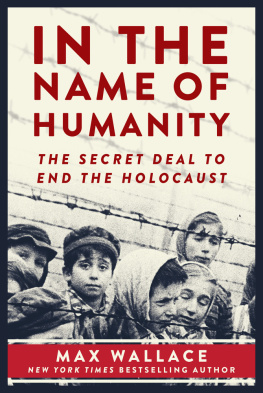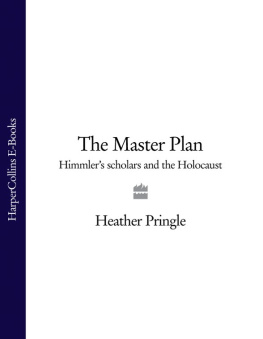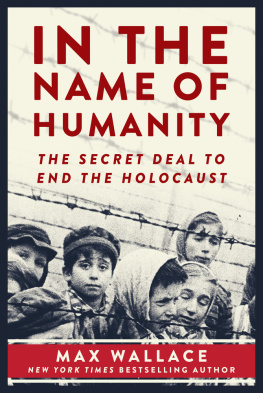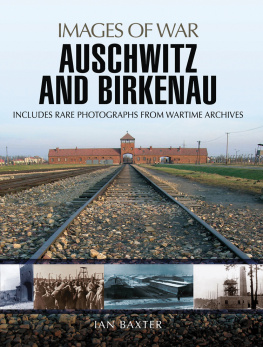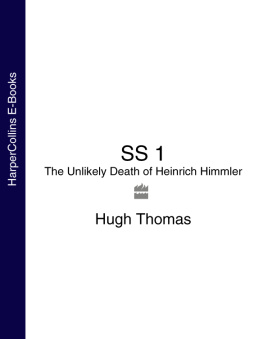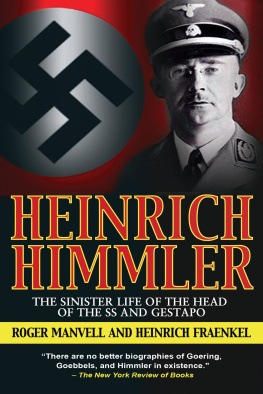

ALSO BY MAX WALLACE
The American Axis
Muhammad Alis Greatest Fight
Love & Death

Copyright 2018 by Max Wallace
First published 2017 by Allen Lane, an imprint of Penguin Canada, a division of Penguin Random House Canada Limited
All rights reserved. No part of this book may be reproduced in any manner without the express written consent of the publisher, except in the case of brief excerpts in critical reviews or articles. All inquiries should be addressed to Skyhorse Publishing, 307 West 36th Street, 11th Floor, New York, NY 10018.
Skyhorse Publishing books may be purchased in bulk at special discounts for sales promotion, corporate gifts, fund-raising, or educational purposes. Special editions can also be created to specifications. For details, contact the Special Sales Department, Skyhorse Publishing, 307 West 36th Street, 11th Floor, New York, NY 10018 or .
Skyhorse and Skyhorse Publishing are registered trademarks of Skyhorse Publishing, Inc., a Delaware corporation.
Visit our website at www.skyhorsepublishing.com.
10 9 8 7 6 5 4 3 2 1
Library of Congress Cataloging-in-Publication Data is available on file.
Cover design by Rain Saukas
Cover photo credit AP
ISBN: 978-1-5107-3497-5
Ebook ISBN: 978-1-5107-3499-9
Printed in the United States of America
To my late mother, Phyllis Bailey, who taught me to never forget
CONTENTS

AUTHORS NOTE
W hen Schindlers List was released in 1993, Steven Spielbergs epic film served as a powerful antidote to decades of stories focusing only on the darkest elements of the Holocaust. Oskar Schindler, the German industrialist who saved more than a thousand Jews, served as an inspirational figure who came to epitomize the little-known area of Holocaust rescue and reminded the world that not all Germans had acquiesced in their countrys crimes.
Five years later, I was working in Montreal as an interviewer for the Shoah Visual History Foundationthe institute Spielberg established with the proceeds of the film to document the video testimonies of Holocaust survivors and to ensure the world would never forget. Each week, I encountered men and womenJews and non-Jewswho had endured and somehow survived the nightmare. Many of the stories I documented continue to haunt me to this day, each marked with common themes of death and despair, hardly redeemed by the fact that the subjects happened to survive while most of their loved ones ended up in Hitlers ovens.
After spending two years recording many such grim testimonies, however, I learned of a man living in another Canadian city who had a very different story to tell. In the summer of 2000, I traveled to Toronto to meet Hermann Landauthe last living eyewitness to an incredible chapter of history. As the secretary of a Swiss-based rescue organization, Landau had spent more than three years documenting the activities of an extraordinary band of Orthodox Jews who spent every waking moment on a mission that may have dwarfed the significant accomplishments of Schindler and others more familiar to history.
As he shared his remarkable story and generously opened his meticulous archives, I was astonished that the staggering achievements of this group were so little known. It led me to follow an historical trail that, more than fifteen years later, may very well rewrite the history of the Holocaust.
ONE
THE LIFEBOAT IS FULL
E arly in the morning of November 25, 1944, prisoners at Auschwitz-Birkenau heard a deafening explosion. Emerging from their barracks, they witnessed the gas chambers and crematoriapart of the largest killing machine in human historyreduced to rubble. Most assumed they had fallen victim to inmate sabotage and thousands silently cheered. However, the Final Solutions most efficient murder apparatus had not been felled by Jews, but rather by the ruthless architect of mass genocide, SS chief Heinrich Himmler.
On his first morning in GermanyApril 20, 1945Norbert Masur woke up in a cold sweat. From all corners of the Fatherland, leading Nazis were already converging on Berlin for a celebration of Adolf Hitlers fifty-sixth birthday, set to take place that evening in the Fhrerbunker where Hitler had retreated while his Thousand Year Reich crumbled around him. Among the invited guests, in fact, was the man whom Masur had secretly flown to meet.
As he anxiously waited for the meeting to take place, Masur couldnt help but wonder why he had agreed to make the trip, which had been undertaken the night before in the strictest of secrecy. It was a journey fraught with danger and not just from the nearly constant strafing of Allied aircraft while he was driven from Berlins Tempelhof Airport to the lavish estate of the host who had arranged the historic meeting.
Norbert Masur had traveled from Sweden as a representative of the World Jewish Congress to meet the man who had almost singlehandedly been responsible for the decimation of his people. If the Fhrer, holed up in his bunker, were to discover that a member of the hated race was waiting nearby to meet with his most powerful lieutenant, the consequences would almost certainly be catastrophic.
As Masur waited, he had no idea of the events that had led to this improbable journey, nor the role played by an ultra-Orthodox woman he had never heard of in bringing about his fateful mission.
For Hitler, only one task remained before he and his mistress took the cyanide capsules that had been stashed in the bunker ahead of the approaching forcesa Red Army intent on capturing the man responsible for unleashing years of unimaginable suffering. But if the Reich was doomed, the Fhrer was determined as his last act to take every last Jew with him and complete the Final Solution, which had not yet achieved its ultimate aim.
The systematic extermination of European Jewry had come to a halt five months earlier with the destruction of the Auschwitz gas chambers on November 25. Since that time, tens of thousands more Jews had succumbed during brutal death marches, or from the disease and hunger that ravaged the remaining concentration camps. Now, those left alive faced the same fate as the nearly six million who had already fallen victim to the Nazis monstrous genocide, unless something was done to countermand Hitlers orders.
Masurs mission, then, was no less than preventing the imminent extinction of European Jewry. The burden weighed heavily on him as he spent the day awaiting an unlikely encounter that few could have imagined possible. When he was still waiting at midnight, however, it appeared that his trip had been undertaken in vain. Finally, at precisely 2:30 a.m., he heard a car pull up. As the front door opened, Norbert Masur came face-to-face with the Devil.
The fact that there were any Jews left at all to save at this stage of the war could be explained by an extraordinary confluence of events and a disparate cast of characters. Heroes and villains alike came together at historys darkest hour for a variety of motives that historians still struggle to explain.
Today, visitors who flock to St. Gallen, Switzerland, cant help but feel that theyve been transported into a picture postcard. Nestled in a valley between Lake Constance and the spectacular snowcapped mountains of the Appenzell Alps, the small city is surrounded by quaint timbered cottages, verdant rolling fields, and medieval architecture that harkens back to the villages seventh-century founding by an Irish monk. An eighth-century abbey still towers over the city, its library designated a UNESCO heritage site. In the tenth century, the abbey housed a Benedectine nun named Wiborada, who warned locals of an imminent Hungarian invasion and lost her life saving the abbey. For her heroic efforts, Saint Wiborada was the first woman ever canonized by the Roman Catholic Church. Nine centuries later, an equally brave woman would make her mark on the city.
Next page
